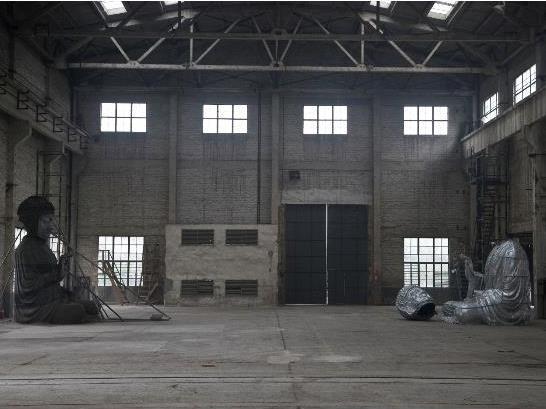Zhang Huan, Taiwan Buddha, 2010, ash, wood, aluminium, steel, 530 x 740 x 350 (left), 530 x 360 x 370 (right). Image courtesy of the artist and PACE, New York.
In association with Sydney Festival and as part of Sydney’s Chinese New Year celebrations, Carriageworks will present Sydney Buddha by Chinese artist Zhang Huan. This large-scale installation in the public space of the Redfern multi-arts institution will comprise a monumental sculpture of the Buddha moulded from ash collected from Chinese temples, facing off against its aluminium doppelganger. As time and atmosphere take effect, the ash sculpture will gradually disintegrate in unpredictable ways.
Prior to relocating to Shanghai in the mid-2000s, Zhang was based in the cosmopolitan art centres of Beijing and New York, and was best known for conceptually-based performance work. His work now takes more traditional forms but continues to address spiritual and cultural themes, with his site-specific works acknowledging the particularities of their location.
The artist has recounted visiting a Shanghai temple upon his return to China, where the floor was covered in ash which had leaked from a large incense burner. To Zhang, ‘these ash remains speak to the fulfilment of millions of hopes, dreams and blessings… When I discovered that in modern times it is processed as garbage, I felt a profound sense of regret and pity. I decided to … collect the ashes and bring them to my studio.’ Now using ash as one of his primary media, Zhang has produced a number of large-scale sculptures (partly a result of the opportunities afforded him from his expansive Shanghai studio space).
Visual Arts curator of Carriageworks Beatrice Gralton enthused that Sydney Buddha has been ‘a fascinating project to navigate and organise,’ not least due to the nature of Zhang’s chosen material, 20 tonnes of ash which has been collected from various provinces in China.
Once the material arrives in Sydney, construction begins. ‘The ash is mixed with water and then…pressed into the cast…with mallets.’ This physically demanding process is undertaken by a team of 12. ‘This takes about 40 hours, and because the mould is over 5 metres tall, they get inside it, pressing into all the crevices,’ says Gralton.
The project embodies Carriageworks’ philosophy of programming works with sometimes unexpected outcomes, as the disintegration of the huge figure will depend on environmental conditions at the time.
Sydney Buddha will mark the third time Carriageworks has presented a large-scale installation work over the summer in its free public space, which in previous years has seen Song Dong’s Waste not and Christian Boltanski’s Chance. Gralton anticipates a broad audience for Sydney Buddha, lured by the Sydney Festival and the Chinese New Year celebrations.
Gralton believes audiences will be intrigued by Zhang’s method ‘of creating something monumental and massive out of something very humble that disappears and dissolves, turns into dirt and dust.’ The DNA of this material is reflective of the diversity of audiences that will pass through Carriageworks to take in Sydney Buddha. As the artist has said, ‘To some…[ash] is a short-lived witness to human spirituality…To me, it carries unseen sedimentary residue, and tremendous human data about the collective and individual subconscious.
‘The task, for me, is to solidify these remains of the spiritual life, and allow this evidence somehow to haunt my [work].’
All quotes by Zhang Huan taken from Zhang Huan: Ash, pub. Haunch of Venison, 2007, UK.





